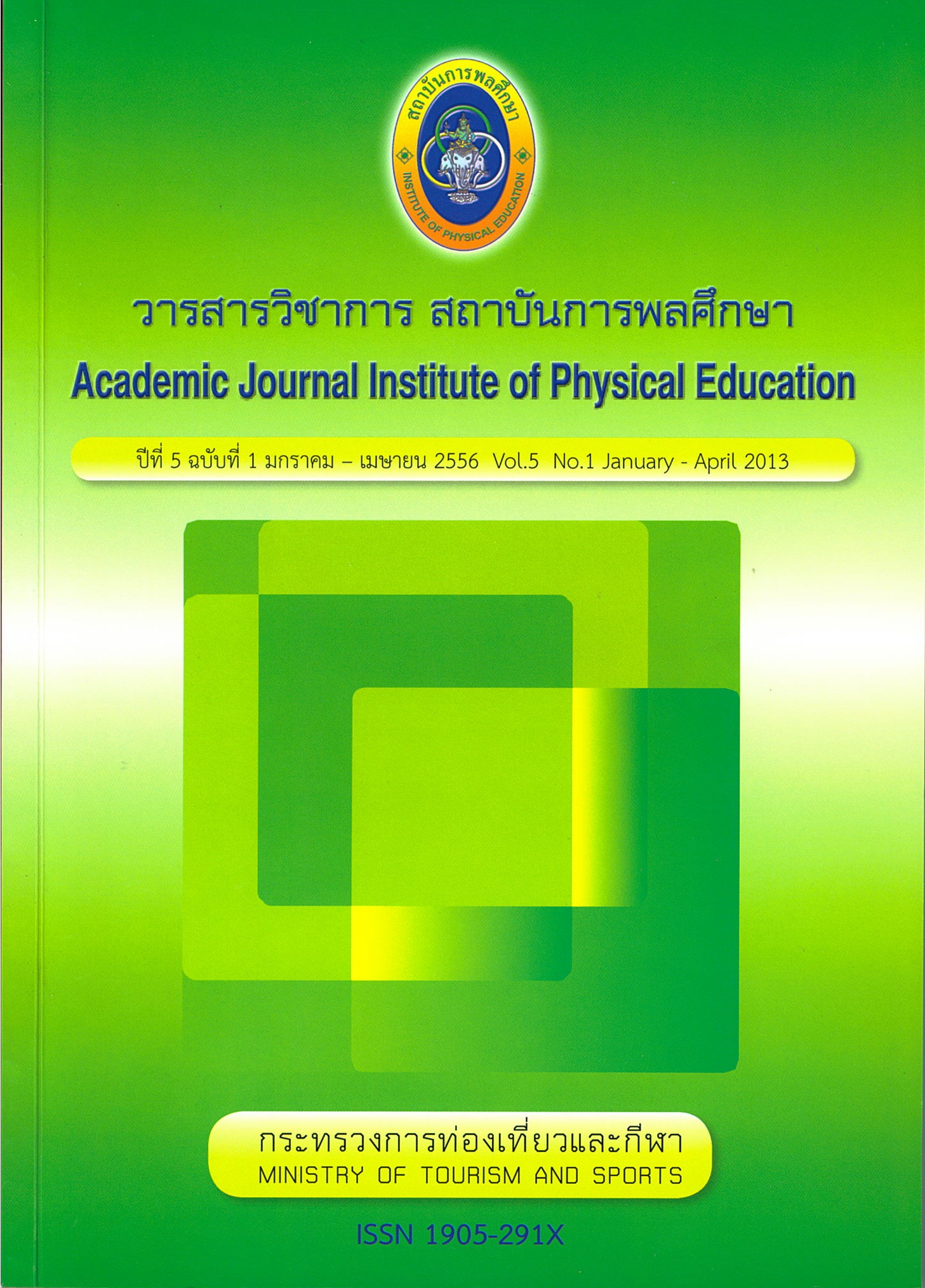Development of A Physical Education Learning Model Based on Backward Design Process
Main Article Content
Abstract
The purposes of this study were to develop and examine the effectiveness of a physical education learning model based on Backward Design Process. The subjects of this study were 373 Mathayom Suksa 1 students randomly selected from 10 schools under the jurisdiction of Ministry of Education, Phranakhon Si Ayutthaya Province. The research methodology was divided into 2 steps: (1) a physical education learning model based on the Backward Design Process was developed and qualitatively inspected by experts. Its content validity and suitability indices were .86 and 4.01 respectively, and (2) the model effectiveness was examined. The research instruments consisted of the physical education learning plans with a content validity index at .98 and the physical education achievement test with a content validity index at .89. Basic statistics and one-way ANOVA with repeated measures were used for analyzing the data.
The research results were as follows:
- The development model of physical education learning based on the Backward Design Process was composed of the following major parts: (1) the basic principles, approaches, and theories of the model with a combination of the Constructivism Theory and the Connectionism Theory, (2) the model objectives, (3) the learning contents, (4) the instruction process, and (5) the learning assessment. The instruction process was divided into 2 phases. Phases 1 concerned designing lesson plans based on the Backward
Design Process consisting of: (1) identifying learning objectives, (2) determining learning evidences, and (3) planning and providing learning experiences. Phase 2 concerned classroom instruction based on the designed lesson plans consisting of 7 steps. They were (1) learner analysis, (2) engagement, (3) exploration, (4) reflection and conclusion, (5) practice, (6) creation, and (7) evaluation.
- The model of physical education learning based on the Backward Design Process was effective in developing student's learning achievement. It was found that the achievement test scores of 287 student subjects (76.96%) were not less than 75%, which was in accordance with the research hypothesis.
- The differences between the pretest (X = 57.00) and the posttest (X = 78.50) of the students' learning achievement test scores were significantly found at .05 level. The differences between the posttest (X = 78.50) and the follow-up test (X = 77.20) were also significantly found at .05 level.
Article Details
The published article is a copyright of the Academic Journal of Thailand National Sports University. The passage appeared in each article in this academic journal is a perspective of each author which is not related to the journal. Each author is required to be responsible for all components of his/her own article. If there are any mistakes, each author must be responsible for those mistakes on his/her own.
References
กษมา วรวรรณ ณ อยุธยา, การออกแบบการเรียนรู้เพื่อสร้างความเข้าใจ. ในเอกสารประกอบการพัฒนาข้าราชการครูเพื่อเลื่อนวิทยฐานะ เป็นครูชํานาญการพิเศษ ครั้งที่ 2 กรณีพิเศษ, กรุงเทพฯ : โรงพิมพ์ชุมนุมสหกรณ์การเกษตรแห่งประเทศไทย, 2548. (อัดสําเนา).
คณะกรรมการการศึกษาแห่งชาติ, สํานักงาน, พระราชบัญญัติการศึกษาแห่งชาติ พ.ศ. 2542 แก้ไขเพิ่มเติม (ฉบับที่ 2) พ.ศ. 2545. กรุงเทพฯ: พริกหวานกราฟฟิก, 2545.
ฉัตรแก้ว เภาวิเศษ, Exploring Educational Change at Classroom Level in Thailand: The Management of the Unknowable. [ออนไลน์]. 2551. แหล่งที่มา: http://www.esanpt1.go.th/adminis/Academic&Research/ExplorinEdChange.html (13 ก.ค. 2554)
เฉลิม ฟักอ่อน, การออกแบบการจัดการเรียนรู้อิงมาตรฐานตามหลักสูตรแกนกลางการศึกษาขั้นพื้นฐานพุทธศักราช 2551 โดยเทคนิค Backward Design, กรุงเทพฯ: สํานักพิมพ์ประสานมิตร (ปสม.), 2552.
เบญจลักษณ์ พงศ์พัชรศักดิ์, การศึกษาผลสัมฤทธิ์ทางการเรียนสังคมศึกษาและความสามารถในการคิดแก้ปัญหาของนักเรียนมัธยมศึกษาปีที่ 5 ที่เรียนโดยการจัดการเรียนรู้ แบบ Backward Design สารนิพนธ์ปริญญาการศึกษามหาบัณฑิต สาขาการมัธยมศึกษา บัณฑิตวิทยา มหาวิทยาลัยศรีนครินทรวิโรฒ, 2553.
ทิศนา แขมมณี, ศาสตร์การสอน: องค์ความรู้เพื่อการจัดกระบวนการเรียนรู้ที่มีประสิทธิภาพ. กรุงเทพฯ: สํานักพิมพ์แห่งจุฬาลงกรณ์มหาวิทยาลัย, 2544.
ทศพร สระแก้ว, ปัญหาการใช้หลักสูตรการศึกษาขั้นพื้นฐาน พุทธศักราช 2544 ของครูผู้สอนพลศึกษา. วิทยานิพนธ์ปริญญามหาบัณฑิต สาขาวิชาพลศึกษา ภาควิชาหลักสูตร การสอนและเทคโนโลยีการศึกษา คณะครุศาสตร์ จุฬาลงกรณ์มหาวิทยาลัย, 2550.
เพ็ญนภา ไพรบูรณ์, ปัญหาการใช้หลักสูตรการศึกษาขั้นพื้นฐาน พุทธศักราช 2544 ของครูผู้สอนกลุ่มสาระการเรียนรู้สุขศึกษาและพลศึกษา วิทยานิพนธ์ปริญญามหาบัณฑิต สาขาวิชาสุขศึกษา ควิชาพลศึกษา คณะครุศาสตร์ จุฬาลงกรณ์มหาวิทยาลัย, 2545.
เลขาธิการสภาการศึกษา, สํานักงาน, ข้อเสนอการปฏิรูปการศึกษาในทศวรรษที่สอง (พ.ศ. 2552-2561). กรุงเทพฯ: พริกหวานกราฟฟิค, 2552.
วาสนา คุณาอภิสิทธิ์ การสอนพลศึกษา. กรุงเทพฯ: วิทยาพัฒน์, 2539.
วิภาวี บุตธรรม. การนําเสนอรูปแบบการเรียนการสอนบนเว็บ วิชาวิทยาศาสตร์ตามแนวคิดการออกแบบย้อนกลับ สําหรับนักเรียนชั้นมัธยมศึกษาปีที่ 1. วิทยานิพนธ์ปริญญามหาบัณฑิต ภาควิชาหลักสูตร การสอนและเทคโนโลยีการศึกษา คณะครุศาสตร์ จุฬาลงกรณ์มหาวิทยาลัย, 2552.
วรศักดิ์ เพียรชอบ. รวมบทความเกี่ยวกับปรัชญา หลักการวิธีการสอนและการวัดเพื่อประเมินผลทางพลศึกษา. กรุงเทพฯ : สํานักพิมพ์แห่งจุฬาลงกรณ์มหาวิทยาลัย, 2547.
ศึกษาธิการ กระทรวง, หลักสูตรแกนกลางการศึกษาขั้นพื้นฐาน พุทธศักราช 2551. กรุงเทพฯ : โรงพิมพ์ชุมนุมสหกรณ์การเกษตรแห่งประเทศไทย, 2551.
Joyce, B. and Weil, M. Models of Teaching. (6th ed.). Boston: Allyn and Bacon, 2000.
Kelting, G. and Marie. L. Preservice teachers' planning and preparation practices: A comparison of lesson and unit plans developed using the backward design model and a traditional model, Teaching and Teacher Education 19 (2003): 304-317.
Wiggins, G. and McTighe, J. Understanding by Design. Virginia: Association for Supervision and Curriculum Development. [Online]. 1998. Available form: http://www.nitesonline.net/download/Backward.pdf [2010, may 10]

